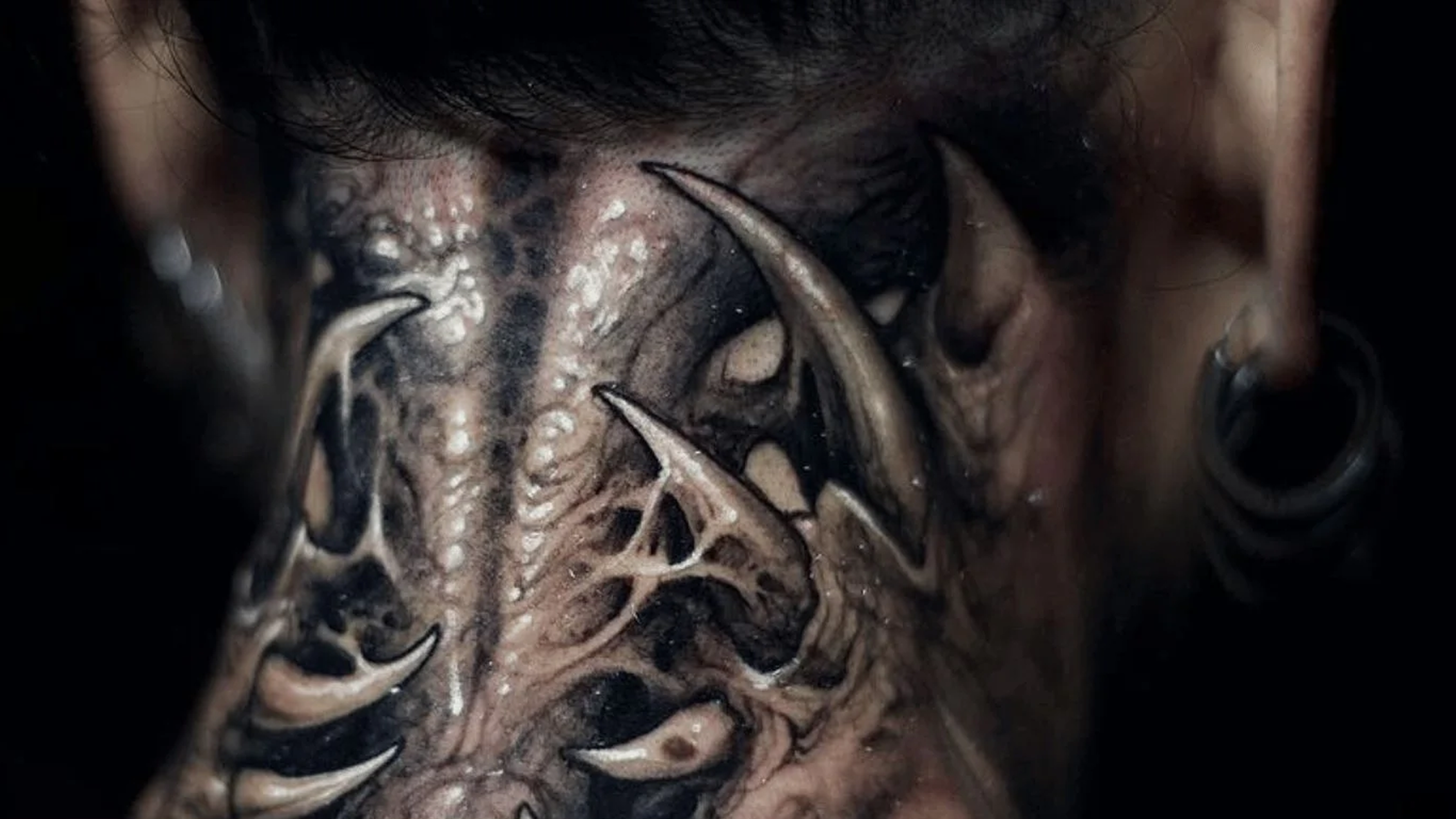Article
The Aesthetics and Techniques of Horror-Based Dark Arts Tattooing
Dark arts tattoos are where the ghoulish and the supernatural mingle. As a subset, these are the tattoos that pay homage not only to horror and slasher films, but can also convey deeper emotional characteristics
November 25, 2024

Dark arts tattoos are where the ghoulish and the supernatural mingle. As a subset, these are the tattoos that pay homage not only to horror and slasher films, but can also convey deeper emotional characteristics. The term, Dark Arts, refers to these iconographic themes and characteristics. Compositionally, dark arts tattoos run a gamut. There are often realistic portrayals of famous slasher film villains. Then there are dense, menacing biomorphic or biomechanical tattoos that work to expose a sinister interiority. Of course, alchemic symbols and demons could play a part too; the effect of dark arts falls somewhere between spooky and terrifying. Just as the source material is diverse, the aesthetics of dark arts tattoos aren’t set in stone: think black and gray, realistic color, and even a mix of the two. Artists Ruben Barahoma, Irv Santana, Paul Booth, Guy Aitchison, Debora Morrigan, and Gara are emblematic of dark arts tattoo tradition.
The CO:CREATE Method
Every tattoo style has a range of expressions. At Co:Create, we acknowledged that range, and are focused on three core considerations for describing the tattoo you want: aesthetic, iconography, and technique.
Aesthetic refers to how the tattoo looks. Line weight, color, saturation, movement with the body all contribute to look.
Iconography examines the meaning attached to the tattoo. We describe the cultural, historical, and spiritual connections chosen imagery carries and communicates.
Technique specifies the methods used to. For example, different techniques of shading (whip, dot, drag, etc.) create different levels of depth and dimension. Color layering, color packing, or distinct forms of linework, all contribute to refining the final form of your tattoo.
Discussing these three elements with your artist helps assure you get your dream tattoo.
Dark Arts Source Material
Alchemic, horror movie figures, horned deities (like Baphomet) are all part of the treasure chest of figurative subjects tailor-made for dark arts tattoos. The work of Swiss artist H.R. Geiger, renowned for his biomorphic illustrations, often inspires complex black and gray designs. Similarly, artists like Larry Carroll and Wes Benscoter, both responsible for some of the most iconic heavy metal album covers, also shape the image base. Derek Riggs, the inventor of Iron Maiden’s zombie mascot, provides other stylistic cues. Hyper Realistic visual artist Gottfried Helnwein and dystopian surrealist Zdzisław Beksiński both create work that has broadened the imagination of dark arts. A deep dive into historic depictions of demons, ghosts, skulls, and skeletons reveals other options. As long as the result is scary or soul-baring, a dark arts tattoo is successful.

H.R. Giger inspired tattoo by Jonny Gomez
Dark Arts Aesthetics
Dark arts tattoos can be rendered in a range of aesthetic styles. Most common are black and gray, realistic, and traditional. In black and gray dark arts tattoos, the contrast of black ink and negative space creates a surreal drama. There isn’t a whole lot of gradation, as you might find in realistic black and gray. Super high contrast is the aim. The tattoos almost burst from the skin. For color tattoos, the same type of painterly blending used in realistic portraiture brings the work to life. Naturally, this is because the majority of color dark arts tattoos depict recognizable figures — like Jason Vorhees and Freddy Kruger. Small-scale, Halloween-adjacent designs nail spooky thematics best through the clear line work and deep color demonstrated in traditional tattooing.
Dark Arts Techniques
Technically, a heavy use of black against negative space is critical for the success of a dark arts, black and gray tattoo. With color, it is all about blending and shading to produce three-dimensionality in the chosen symbol or portrait.
Dark Arts History
Dark arts tattoos hit stride in the mid-90s, with the opening of Paul Booth’s famous Last Rites Tattoo Theatre in New York City. Booth drew from both blackwork and black and gray to forge a sinister aesthetic with instant appeal to heavy metal musicians and fans alike. Of course, spooky tattoos and depictions of the macabre are established elements of the traditional tattoo lexicon. However, what Booth did in delivering pushed beyond iconography and tapped into the powerful nature of blackwork or neo-tribal tattoos, adding enough depth to give the biomorphic feel of dark arts tattoos some three dimensionality.
The dark arts tradition owes significantly to the influence of tattoo artists in Central and Eastern Europe as well. Hungarian-born Boris Tattoo, a pioneer of color realism, helped spur popularity for color portraits depicting horror movie villains and other counterparts from comics, tv, and more broadened the scope and while perhaps better classified as horror tattoos, certainly fit into the broad classification of dark themes. Coming from an area with little tattoo tradition (due, primarily, to communist rule), Boris helped to instigate a generation of European tattooers — among them Robert Hernandez and Jack Ribeiro — blending techniques and aesthetics who continue to expand the themes associated with dark arts tattooing.
Dark Arts Artists
Dark Art artists accepting bookings on CO:CREATE include Ruben Barahona, Jonny Gomez, and Dom Cali. Others on the curated list of artists include Nathan Marti, Irv Santana, David Jorquera, Debora Morrigan, Pasha Novikov, Gara, Rob Borbas
See the full list of Dark Art artists here.
Discover
Artists
Connect
© 2025 Gesso Labs, Inc.
Privacy PolicyTerms of ServiceReferral TermsGiveaway RulesArtist AddendumAI & LLM
























